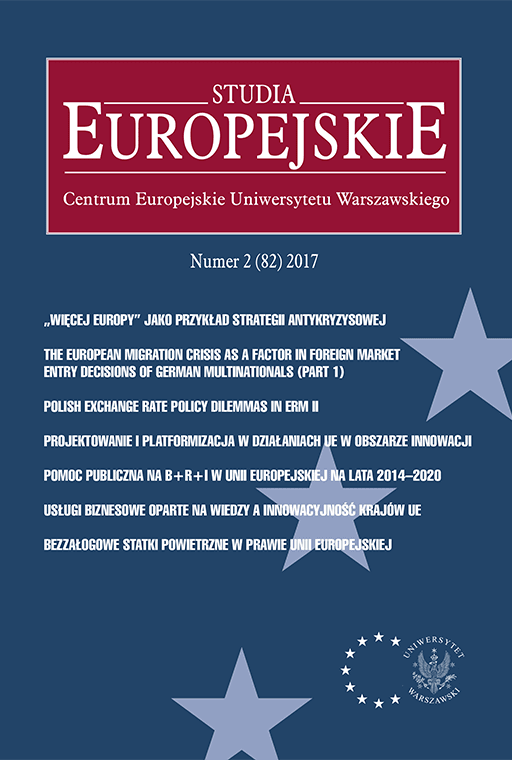
ISSUE: 2/2017
- Volume 82
- Number 2
- 2017
Subscribe NEWSLETTER
Studia Europejskie –
Studies in European Affairs
ISSN: 1428-149X
e-ISSN: 2719-3780
License
Articles published in the journal are under a Creative Commons Attribution – Non Commercial – No Derivatives 4.0 International License
Trans-European Transport Corridors as an Element of Poland’s Land Use
Abstract
The aim of the article is to analyze how selected elements of trans-European corridor network are consistent with land use within the boundaries of Poland. The Baltic–Adriatic and Baltic-North Sea corridors comprise both roads and rail lines. In the case of rail the only points which may be included in the traffic are stops, stations or handling points of different kinds. Also the analysis of accessibility to the road network is single-point in character as corridors function on the basis of the highest category roads (motorways and expressways), which are connected with the road network surrounding them only in nodes with slip-roads. This is
why analyses of accessibility to the trans-European network are based in this research on analysis of accessibility of points. Cumulative accessibility is the main research method which finds its specifi cation in the subsequent part of this work. Thanks to it it was possible to specify the level of adjustment of corridor routes and their point infrastructure elements to the elements of land development of Poland’s space, including its settlement network, distribution of demographic potential or economic activity. Research was conducted for several variants of movement: foot travel, journeys on the road and rail network as well as the multimodal network representing different confi gurations of the aforementioned transport modes, both for passenger and goods transport. The article presents the situation as of August 2016.
References
Act as of 20 June 1997 on Traffic Law, Dz.U. 1997 No. 98 Item 602 as amended.
Allen J., Browne M., Cherrett T., Investigating relationships between road freight transport, facility location, logistics management and urban form, “Journal of Transport Geography”, No. 24/2012.
Baltic Transport Outlook 2030, Executive Report – final version, December 2011, www.baltictransportoutlook.eu/BTO2030_Executive_Report_Final_15- 12-2011_new.pdf (last visited 9.08.2016).
Baltic-Adriatic Core Network Corridor Study Draft Final Report, 2014, LeighFisher Limited Jacobs Polska NDCON, Paradigma, ASTRAPROJEKT d.o.o.
BDL – Bank of Local Data – www.stat.gov.pl www.stat.gov.pl (last visited 9.08.2016).
Bruinsma F.R., Rietveld P., The Accessibility of European Cities: Theoretical Framework and Comparison of Approaches, “Environment and Planning”, No. 30, Vol. 3/1998.
Consolidated versions of the Treaty on the European Union and the Treaty on the Functioning of the European, Offi cial Journal of the European Union No. C 326 as of 26 October 2012.
Fozza S., Recagno V., Sustainable Technologies and Innovation for Green Corridors: Survey and Application, “Procedia – Social and Behavioral Sciences”, No. 48/2012.
Gaca S., Suchorzewski W., Tracz T., Inżynieria ruchu drogowego. Teoria i praktyka, Wydawnictwo Komunikacji i Łączności, Warsaw 2008.
Gould P., Spatial Diffusion. Resource Paper No. 17, Washington, DC: Association of American Geographers, 1969.
Haklay M., How good is volunteered geographical infromation? A comparative study of OpenStreetMap an Ordance Survey datasets, “Environment and Planning B: Planning and Design”, Vol. 37/2010.
Handy S.L., Niemeier D.A., Measuring Accessibility: an Exploration of Issues and Alternatives, “Environment and Planning A”, No. 29/1997.
Hansen W.G., How Accessibility Shapes Land-use, “Journal of the American Institute of Planners”, No. 25/1959.
Loose W., Flächennutzungsplan 2010 Freiburg – Stellungnahme zu den verkehrlichen Auswirkungen, Öko–Institut e.V., Freiburg 2001.
Majewski B., Beim M., Dostępność komunikacji publicznej w Poznaniu, in: Nowe kierunki i metody w analizie regionalnej, eds. Czyż T., Stryjakiewicz T., Churski P., Biuletyn IGSE i GP UAM, Seria Rozwój Regionalny i Polityka Regionalna No. 3, Bogucki Wydawnictwo Naukowe, Poznań 2008.
Regulation (EU) No. 1315/2013 of the European Parliament and of the Council of 11 December 2013 on Union guidelines for the development of the trans-European transport network.
Regulation (EU) No. 1316/2013 of the European Parliament and of the Council of 11 December 2013 establishing the Connecting Europe Facility, amending Regulation (EU) No. 913/2010 and repealing Regulations (EC) No 680/2007 and (EC) No. 67/2010.
Śleszyński P., Możliwości rozwoju regionalnych portów lotniczych w Polsce w świetle uwarunkowań popytowych, „Prace
Komisji Geografi i Komunikacji PTG”, No. 13/2007.
Śleszyński P., Komornicki T., Wpływ rozwoju sieci drogowej na obszary rynkowe istniejących i planowanych portów lotniczych (2008–2015), „Drogi. Lądowe, powietrzne, wodne”, no. 9/2009.
The General Directorate for National Roads and Motorways website, www.gddkia.gov.pl/pl/a/9865/zielone-korytarze-z-gddkia.
Language: English
Pages: 195-221
How to Cite:
Harvard
Wiśniewski, S. (2017) "Trans-European Transport Corridors as an Element of Poland’s Land Use". Studia Europejskie – Studies in European Affairs, 2/2017, pp. 195-221.